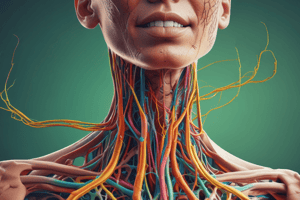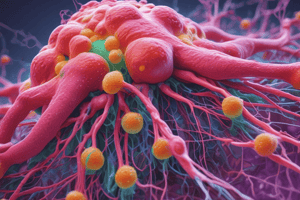Podcast
Questions and Answers
Which of the following is a primary function of the lymphatic system in relation to tissue fluid?
Which of the following is a primary function of the lymphatic system in relation to tissue fluid?
- To secrete hormones into the tissue fluid.
- To transport tissue fluid directly into arterial circulation.
- To drain excess tissue fluid. (correct)
- To produce tissue fluid within the lymphatic organs.
How does the lymphatic system contribute to the body's defenses?
How does the lymphatic system contribute to the body's defenses?
- By producing red blood cells to combat infections.
- By initiating fever and inflammation only.
- By housing lymphocytes and facilitating immune responses. (correct)
- By directly attacking pathogens in the bloodstream.
What is the significance of the lymphatic system providing an 'alternate highway' for fluid transport?
What is the significance of the lymphatic system providing an 'alternate highway' for fluid transport?
- It prevents fluid leakage from blood vessels.
- It allows fluid to bypass the cardiovascular system entirely.
- It increases blood pressure during physical activity.
- It ensures fluid can travel independently of arteries and veins. (correct)
How do lymphatic vessels change in size as they approach the heart?
How do lymphatic vessels change in size as they approach the heart?
What causes interstitial fluid to enter lymphatic capillaries and become lymph?
What causes interstitial fluid to enter lymphatic capillaries and become lymph?
When is interstitial fluid referred to as lymph?
When is interstitial fluid referred to as lymph?
What is a common characteristic shared by lymphatic organs?
What is a common characteristic shared by lymphatic organs?
Which of the following is the primary role of lymphocytes produced in lymphatic organs?
Which of the following is the primary role of lymphocytes produced in lymphatic organs?
What structural component is essential for lymphatic organs to provide an alternate route for fluid?
What structural component is essential for lymphatic organs to provide an alternate route for fluid?
What is the main function of the spleen within the lymphatic system?
What is the main function of the spleen within the lymphatic system?
How do splenic arteries and veins contribute to the spleen's function?
How do splenic arteries and veins contribute to the spleen's function?
What is the role of afferent lymphatic vessels in relation to a lymph node?
What is the role of afferent lymphatic vessels in relation to a lymph node?
What describes the action of efferent lymphatic vessels?
What describes the action of efferent lymphatic vessels?
What is the primary function of lymph nodes within the lymphatic system?
What is the primary function of lymph nodes within the lymphatic system?
Which area of the body does the right lymphatic duct primarily drain?
Which area of the body does the right lymphatic duct primarily drain?
Approximately what percentage of the body's lymph is drained by the thoracic duct?
Approximately what percentage of the body's lymph is drained by the thoracic duct?
Which of the following regions is drained by the thoracic duct but not by the right lymphatic duct?
Which of the following regions is drained by the thoracic duct but not by the right lymphatic duct?
In addition to the upper limb and thorax, the right lymphatic duct drains lymph from which location?
In addition to the upper limb and thorax, the right lymphatic duct drains lymph from which location?
Which of the following anatomical regions is drained by the thoracic duct?
Which of the following anatomical regions is drained by the thoracic duct?
Compared to the right lymphatic duct, what additional major body region is drained by the thoracic duct?
Compared to the right lymphatic duct, what additional major body region is drained by the thoracic duct?
Flashcards
Lymphatic System Functions
Lymphatic System Functions
Drains excess tissue fluid, aids in defense response and provides an alternate highway for fluid to travel.
Lymph
Lymph
Interstitial fluid that enters a lymphatic capillary due to pressure gradients.
Lymphatic Organs
Lymphatic Organs
Organs containing lymphatic tissue that produce lymphocytes.
List of Lymphatic Organs
List of Lymphatic Organs
Signup and view all the flashcards
Right Lymphatic Duct
Right Lymphatic Duct
Signup and view all the flashcards
Thoracic Duct
Thoracic Duct
Signup and view all the flashcards
Spleen
Spleen
Signup and view all the flashcards
Afferent Lymphatic Vessel
Afferent Lymphatic Vessel
Signup and view all the flashcards
Efferent Lymphatic Vessel
Efferent Lymphatic Vessel
Signup and view all the flashcards
Study Notes
Lymphatic System
- Drains excess tissue fluid
- Defense response
- Provides an alternate highway for fluid to travel instead of arteries and veins
- Lymphatic System flows alongside the circulatory system
- Lymphatic capillaries and vessels get larger as they get closer to the heart
- Due to differences in pressure gradients at capillary beds, interstitial fluid will enter a Lymphatic capillary and become Lymph
- Lymph is the name of the fluid once it is inside a lymphatic vessel
- Lymphatic organs and structures contain lymphatic tissue and have the ability to produce lymphocytes (white blood cells)
Lymphatic Organs
- Tonsils
- Thymus
- Spleen
- Peyer's Patches of the small intestine
- Bone marrow
- Thoracic duct
- Right Lymphatic duct (R.LD)
Lymphatic Structures
- Right Lymphatic Duct collects lymphatic drainage from the right side of the head, neck, thorax, and upper limb
- Right Lymphatic Duct drains ~25% of the lymph in the body
- Thoracic Duct collects lymphatic drainage from the left side of the head and neck, thorax, upper limb and everything inferior to the diaphragm
- Thoracic Duct drains ~ 75% of the lymph in the body
Spleen
- Main Lymphatic organ
- Filters blood
- Removes old red blood cells
- Splenic artery supplies the spleen with oxygenated blood
- Splenic vein drains the deoxygenated blood from the spleen
Lymph Node
- A filter of the Lymphatic system
- Afferent lymphatic vessel brings lymph into the node
- Lymphatic vessels enter the node and clean the lymph
- Efferent lymphatic vessel drains lymph from the node
Studying That Suits You
Use AI to generate personalized quizzes and flashcards to suit your learning preferences.




